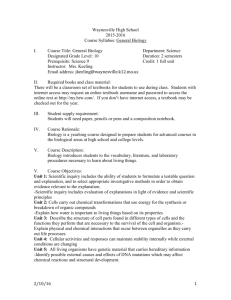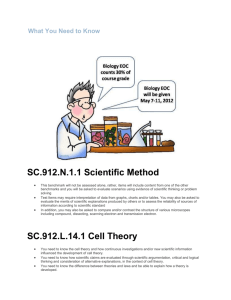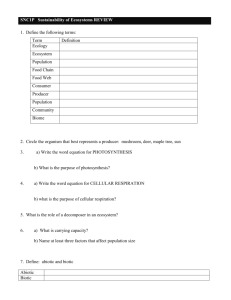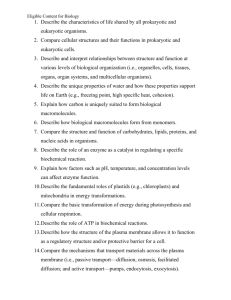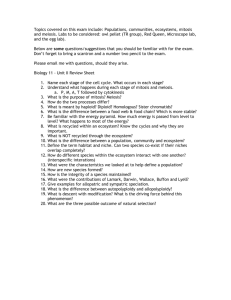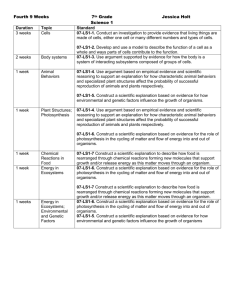7th Grade Life Science/Biology Curriculum Alignment
advertisement
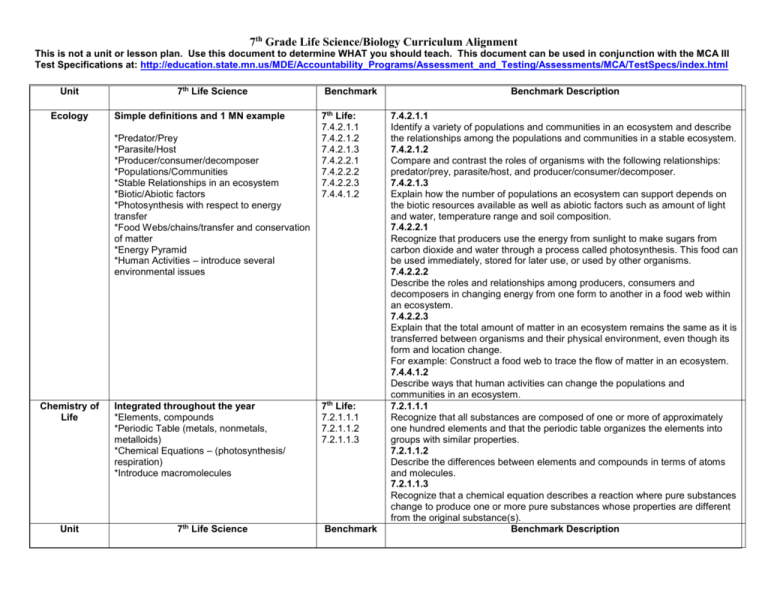
7th Grade Life Science/Biology Curriculum Alignment This is not a unit or lesson plan. Use this document to determine WHAT you should teach. This document can be used in conjunction with the MCA III Test Specifications at: http://education.state.mn.us/MDE/Accountability_Programs/Assessment_and_Testing/Assessments/MCA/TestSpecs/index.html Unit Ecology 7th Life Science Simple definitions and 1 MN example *Predator/Prey *Parasite/Host *Producer/consumer/decomposer *Populations/Communities *Stable Relationships in an ecosystem *Biotic/Abiotic factors *Photosynthesis with respect to energy transfer *Food Webs/chains/transfer and conservation of matter *Energy Pyramid *Human Activities – introduce several environmental issues Chemistry of Life Unit Integrated throughout the year *Elements, compounds *Periodic Table (metals, nonmetals, metalloids) *Chemical Equations – (photosynthesis/ respiration) *Introduce macromolecules 7th Life Science Benchmark 7th Life: 7.4.2.1.1 7.4.2.1.2 7.4.2.1.3 7.4.2.2.1 7.4.2.2.2 7.4.2.2.3 7.4.4.1.2 7th Life: 7.2.1.1.1 7.2.1.1.2 7.2.1.1.3 Benchmark Benchmark Description 7.4.2.1.1 Identify a variety of populations and communities in an ecosystem and describe the relationships among the populations and communities in a stable ecosystem. 7.4.2.1.2 Compare and contrast the roles of organisms with the following relationships: predator/prey, parasite/host, and producer/consumer/decomposer. 7.4.2.1.3 Explain how the number of populations an ecosystem can support depends on the biotic resources available as well as abiotic factors such as amount of light and water, temperature range and soil composition. 7.4.2.2.1 Recognize that producers use the energy from sunlight to make sugars from carbon dioxide and water through a process called photosynthesis. This food can be used immediately, stored for later use, or used by other organisms. 7.4.2.2.2 Describe the roles and relationships among producers, consumers and decomposers in changing energy from one form to another in a food web within an ecosystem. 7.4.2.2.3 Explain that the total amount of matter in an ecosystem remains the same as it is transferred between organisms and their physical environment, even though its form and location change. For example: Construct a food web to trace the flow of matter in an ecosystem. 7.4.4.1.2 Describe ways that human activities can change the populations and communities in an ecosystem. 7.2.1.1.1 Recognize that all substances are composed of one or more of approximately one hundred elements and that the periodic table organizes the elements into groups with similar properties. 7.2.1.1.2 Describe the differences between elements and compounds in terms of atoms and molecules. 7.2.1.1.3 Recognize that a chemical equation describes a reaction where pure substances change to produce one or more pure substances whose properties are different from the original substance(s). Benchmark Description Cells Genetics *Basic Shape and Function of parts – nucleus, cell membrane (only that it surrounds the cell), cytoplasm, cell wall, chloroplasts, mitochondria, vacuole, ribosomes *Structure and Function of cell types – nervous, skin, muscle, bone, blood *Differences between plant and animal *Cell Theory *Cell Division (need to know term mitosis) *Expose to term: Chromosomes *Photosynthesis – know chemical reaction 7th Life: 7.4.1.1.1 7.4.1.2.1 7.4.1.2.2 7.4.1.2.3 *Mendelian inheritance *Expose to terms: phenotype, genotype, homozygous, heterozygous *Monohybrid crosses and punnett squares *Asexual and Sexual (sex cells have ½ the genes) reproduction *Inherited vs. acquired traits *Learned behavior vs. instinctual behavior *Selective Breeding (here or with evolution) 7th Life: 7.4.3.1.1 7.4.3.1.2 7.4.3.1.3 7.4.4.1.1 If time permits: DNA structure Unit Evolution 7th Life Science *Selective Breeding (here or with genetics) *Fossil Record (if time permits, talk about other evidence for evolution) Benchmark 7th Life: 7.4.3.2.1 7.4.3.2.2 7.4.1.1.1 Recognize that all cells do not look alike and that specialized cells in multicellular organisms are organized into tissues and organs that perform specialized functions. For example: Nerve cells and skin cells do not look the same because they are part of different organs and have different functions. 7.4.1.2.1 Recognize that cells carry out life functions, and that these functions are carried out in a similar way in all organisms, including, animals, plants, fungi, bacteria and protists. 7.4.1.2.2 Recognize that cells repeatedly divide to make more cells for growth and repair. 7.4.1.2.3 Use the presence of the cell wall and chloroplasts to distinguish between plant and animal cells. For example: Compare microscopic views of plant cells and animal cells. 7.4.3.1.1 Recognize that cells contain genes and that each gene carries a single unit of information that either alone, or with other genes, determines the inherited traits of an organism. 7.4.3.1.2 Recognize that in asexually reproducing organisms all the genes come from a single parent, and that in sexually reproducing organisms about half of the genes come from each parent. 7.4.3.1.3 Distinguish between characteristics of organisms that are inherited and those acquired through environmental influences. 7.4.4.1.1 Describe examples where selective breeding has resulted in new varieties of cultivated plants and particular traits in domesticated animals. Benchmark Description 7.4.3.2.1 Explain how the fossil record documents the appearance, diversification and extinction of many life forms. Disease and Human Body Unit Ecology *Variation (introduce natural selection and adaptation) *Extinction *Cladograms 7.4.3.2.3 7.4.3.2.4 7.4.4.1.1 Most of this unit will be devoted to the human body systems *Levels of organization in body *Structure and Function of cell types – nervous, skin, muscle, bone, blood *Respiratory *Circulatory *Digestive *Nervous *Skin *Urinary *How pathogens infect the human body (introduce) *Immune system (introduce) *Treating disease (introduce) *Vaccines (introduce) *Communicable vs non-communicable diseases *Bacterial resistance 7th Life: 7.4.1.1.2 7.4.4.2.1 7.4.4.2.2 7.4.4.2.3 7.4.4.2.4 Biology Part 1: Begin with review of 7th grade concepts *Carrying Capacity including limiting factors *Introduced/invasive species *Energy pyramid Benchmark Biology: 9.4.2.1.1 9.4.2.1.2 9.4.2.2.2 7.4.3.2.2 Use internal and external anatomical structures to compare and infer relationships between living organisms as well as those in the fossil record. 7.4.3.2.3 Recognize that variation exists in every population and describe how a variation can help or hinder an organism’s ability to survive. 7.4.3.2.4 Recognize that extinction is a common event and it can occur when the environment changes and a population’s ability to adapt is insufficient to allow its survival. 7.4.4.1.1 Describe examples where selective breeding has resulted in new varieties of cultivated plants and particular traits in domesticated animals. 7.4.1.1.2 Describe how the organs in the respiratory, circulatory, digestive, nervous, skin and urinary systems interact to serve the needs of vertebrate organisms. 7.4.4.2.1 Explain how viruses, bacteria, fungi and parasites may infect the human body and interfere with normal body functions. 7.4.4.2.2 Recognize that a microorganism can cause specific diseases and that there are a variety of medicines available that can be used to combat a given microorganism. 7.4.4.2.3 Recognize that vaccines induce the body to build immunity to a disease without actually causing the disease itself. 7.4.4.2.4 Recognize that the human immune system protects against microscopic organisms and foreign substances that enter from outside the body and against some cancer cells that arise from within. Benchmark Description 9.4.2.1.1 Describe factors that affect the carrying capacity of an ecosystem and relate these to population growth. 9.4.2.1.2 Explain how ecosystems can change as a result of the introduction of one or more new species. For example: The effect of migration, localized evolution or disease Part 2: *Cycles with emphasis on carbon, oxygen *Photosynthesis/Respiration (here or with cells) *Plant based homeostasis *Human Impact – pick 1 environmental issue to tie into health, social, economic, and ecological risks organisms. 9.4.2.2.2 Explain how matter and energy is transformed and transferred among organisms in an ecosystem, and how energy is dissipated as heat into the environment. 9.4.2.2.1 9.4.4.1.2 9.4.4.1.3 9.4.4.2.4 Chemistry of Life *Macromolecules – elements, basic molecular structure and primary functions *Enzymes – role and effect of variables Biology: 9.4.1.2.1 9.4.1.2.2 Unit Cells Biology *Cell sizes, complexity and general structure (viruses can be included here or with diseases) *Structure and Function of parts *Cell membrane and transport *Mitosis *Cancer (here or with immune system) *Photosynthesis/Respiration (here or with Benchmark Biology: 9.4.1.1.1 9.4.1.2.3 9.4.1.2.4 9.4.1.2.5 9.4.1.2.6 9.4.2.2.1 9.4.3.2.2 9.4.2.2.1 Use words and equations to differentiate between the processes of photosynthesis and respiration in terms of energy flow, beginning reactants and end products. 9.4.4.1.2 Describe the social, economic and ecological risks and benefits of changing a natural ecosystem as a result of human activity. For example: Changing the temperature or composition of water, air or soil; altering the populations and communities, developing artificial ecosystems; or changing the use of land or water. 9.4.4.1.3 Describe contributions from diverse cultures, including Minnesota American Indian tribes and communities, to the understanding of interactions among humans and living systems. For example: American Indian understanding of sustainable land use practices. 9.4.4.2.4 Explain how environmental factors and personal decisions, such as water quality, air quality and smoking affect personal and community health. 9.4.1.2.1 Recognize that cells are composed primarily of a few elements (carbon, hydrogen, oxygen, nitrogen, phosphorus, and sulfur), and describe the basic structures and the primary functions of carbohydrates, lipids, proteins and nucleic acids. 9.4.1.2.2 Recognize that the work of the cell is carried out primarily by proteins, most of which are enzymes, and that protein function depends on the amino acid sequence and the shape it takes as a consequence of the interactions between those amino acids. Benchmark Description 9.4.1.1.1 Explain how cell processes are influenced by internal and external factors, such as pH and temperature, and how cells and organisms respond to changes in their environment to maintain homeostasis. 9.4.1.2.3 Describe how viruses, prokaryotic cells and eukaryotic cells differ in relative size, complexity and general structure. 9.4.1.2.4 Explain the function and importance of cell organelles for prokaryotic and/or eukaryotic cells as related to the basic cell processes of respiration, photosynthesis, protein synthesis and cell reproduction. ecology) *Homeostasis (here or with human body) 9.4.4.2.5 *Meiosis (here or with genetics) Genetics *Meiosis (here or with cells) *Chromosome and DNA Structure *DNA replication *Protein Synthesis *Monohybrid crosses – must know terminology *Mendel’s Laws *Mutations *Incomplete dominance, sex linked, polygenic, co-dominance, multiple alleles, dihybrid crosses *Biotechnology/Genetic engineering *Genetic Testing Biology: 9.4.3.1.1 9.4.3.1.2 9.4.3.1.3 9.4.3.2.1 9.4.3.2.2 9.4.3.2.3 9.4.4.1.1 Unit Evolution Biology *Darwin *Adaptation *Natural Selection *Evidence for Evolution *Artificial Selection *Genetic variation *Speciation Benchmark Biology: 9.4.3.3.1 9.4.3.3.2 9.4.3.3.3 9.4.3.3.4 9.4.3.3.5 9.4.3.3.6 9.4.1.2.5 Compare and contrast passive transport (including osmosis and facilitated transport) with active transport, such as endocytosis and exocytosis. 9.4.1.2.6 Explain the process of mitosis in the formation of identical new cells and maintaining chromosome number during asexual reproduction. 9.4.2.2.1 Use words and equations to differentiate between the processes of photosynthesis and respiration in terms of energy flow, beginning reactants and end products. 9.4.3.2.2 Use the processes of mitosis and meiosis to explain the advantages and disadvantages of asexual and sexual reproduction. 9.4.4.2.5 Recognize that a gene mutation in a cell can result in uncontrolled cell division called cancer, and how exposure of cells to certain chemicals and radiation increases mutations and thus increases the chance of cancer. 9.4.3.1.1 Explain the relationships among DNA, genes and chromosomes. 9.4.3.1.2 In the context of a monohybrid cross, apply the terms phenotype, genotype, allele, homozygous and heterozygous. 9.4.3.1.3 Describe the process of DNA replication and the role of DNA and RNA in assembling protein molecules. 9.4.3.2.1 Use concepts from Mendel’s laws of segregation and independent assortment to explain how sorting and recombination (crossing over) of genes during sexual reproduction (meiosis) increases the occurrence of variation in a species. 9.4.3.2.2 Use the processes of mitosis and meiosis to explain the advantages and disadvantages of asexual and sexual reproduction. 9.4.3.2.3 Explain how mutations like deletions, insertions, rearrangements or substitutions of DNA segments in gametes may have no effect, may harm, or rarely may be beneficial, and can result in genetic variation within a species. 9.4.4.1.1 Describe the social, economic and ecological risks and benefits of biotechnology in agriculture and medicine. For example: Selective breeding, genetic engineering, and antibiotic development and use. Benchmark Description 9.4.3.3.1 Describe how evidence led Darwin to develop the theory of natural selection and common descent to explain evolution. 9.4.3.3.2 Use scientific evidence, including the fossil record, homologous structures, and genetic and/or biochemical similarities, to show evolutionary relationships among species. 9.4.3.3.3 Recognize that artificial selection has led to offspring through successive generations that can be very different in appearance and behavior from their Disease and Human Body *Homeostasis (here or with cells) *Review these body system: digestive, respiratory, circulatory, and nervous *Viruses, bacteria, and other pathogens (here or with cells) *Immune System *Immune Response *Vaccines *Cancer (here or with mitosis) *Allergies Biology: 9.4.1.1.2 9.4.4.2.1 9.4.4.2.2 9.4.4.2.3 9.4.4.2.4 9.4.4.2.5 distant ancestors. 9.4.3.3.4 Explain why genetic variation within a population is essential for evolution to occur. 9.4.3.3.5 Explain how competition for finite resources and the changing environment promotes natural selection on offspring survival, depending on whether the offspring have characteristics that are advantageous or disadvantageous in the new environment. 9.4.3.3.6 Explain how genetic variation between two populations of a given species is due, in part, to different selective pressures acting independently on each population and how, over time, these differences can lead to the development of new species. 9.4.1.1.2 Describe how the functions of individual organ systems are integrated to maintain homeostasis in an organism. 9.4.4.2.1 Describe how some diseases can sometimes be predicted by genetic testing and how this affects parental and community decisions. 9.4.4.2.2 Explain how the body produces antibodies to fight disease and how vaccines assist this process. 9.4.4.2.3 Describe how the immune system sometimes attacks some of the body’s own cells and how some allergic reactions are caused by the body's immune responses to usually harmless environmental substances. 9.4.4.2.4 Explain how environmental factors and personal decisions, such as water quality, air quality and smoking affect personal and community health. 9.4.4.2.5 Recognize that a gene mutation in a cell can result in uncontrolled cell division called cancer, and how exposure of cells to certain chemicals and radiation increases mutations and thus increases the chance of cancer.
